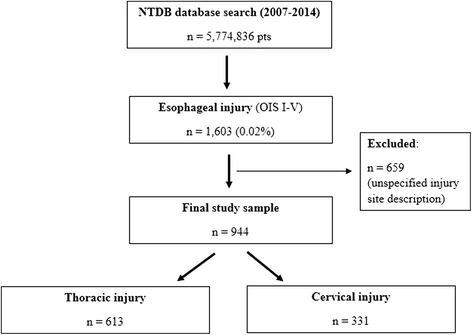Non-iatrogenic esophageal injury: a retrospective analysis from the National Trauma Data Bank
- PMID: 28465715
- PMCID: PMC5408440
- DOI: 10.1186/s13017-017-0131-8
Non-iatrogenic esophageal injury: a retrospective analysis from the National Trauma Data Bank
Abstract
Background: Traumatic, non-iatrogenic esophageal injuries, despite their rarity, are associated with significant morbidity and mortality. The optimal management of these esophageal perforations remains largely debated. To date, only a few small case series are available with contrasting results. The purpose of this study was to examine a large contemporary experience with traumatic esophageal injury management and to analyze risk factors associated with mortality.
Methods: This National Trauma Data Bank (NTDB) database study included patients with non-iatrogenic esophageal injuries. Variables abstracted were demographics, comorbidities, mechanism of injury, Abbreviated Injury Scale (AIS), esophageal Organ Injury Scale (OIS), Injury Severity Score (ISS), level of injury, vital signs, and treatment. Multivariate analysis was used to identify independent predictors for mortality and overall complications.
Results: A total of 944 patients with non-iatrogenic esophageal injury were included in the final analysis. The cervical segment of the esophagus was injured in 331 (35%) patients. The unadjusted 24-h mortality (8.2 vs. 14%, p = 0.008), 30-day mortality (4.2 vs. 9.3%, p = 0.005), and overall mortality (7.9 vs. 13.5%, p = 0.009) were significantly lower in the group of patients with a cervical injury. The overall complication rate was also lower in the cervical group (19.8 vs. 27.1%, p = 0.024). Multilogistic regression analysis identified age >50, thoracic injury, high-grade esophageal injury (OIS IV-V), hypotension on admission, and GCS <9 as independent risk factors associated with increased mortality. Treatment within the first 24 h was found to be protective (OR 0.284; 95% CI, 0.148-0.546; p < 0.001). Injury to the thoracic esophagus was also an independent risk factor for overall complications (OR 1.637; 95% CI, 1.06-2.53; p = 0.026).
Conclusions: Despite improvements in surgical technique and critical care support, the overall mortality for traumatic esophageal injury remains high. The presence of a thoracic esophageal injury and extensive esophageal damage are the major independent risk factors for mortality. Early surgical treatment, within the first 24 h of admission, is associated with improved survival.
Trial registration: iStar, HS-16-00883.
Keywords: Esophageal trauma; Non-iatrogenic esophageal injury; Outcomes; Primary suture.
Figures
Similar articles
-
Splenic artery embolization versus splenectomy: Analysis for early in-hospital infectious complications and outcomes.J Trauma Acute Care Surg. 2017 Sep;83(3):356-360. doi: 10.1097/TA.0000000000001550. J Trauma Acute Care Surg. 2017. PMID: 28459796
-
Penetrating injuries to the duodenum: An analysis of 879 patients from the National Trauma Data Bank, 2010 to 2014.J Trauma Acute Care Surg. 2017 Nov;83(5):810-817. doi: 10.1097/TA.0000000000001604. J Trauma Acute Care Surg. 2017. PMID: 28658014
-
Is there an association between female gender and outcome in severe trauma? A multi-center analysis in the Netherlands.Scand J Trauma Resusc Emerg Med. 2019 Feb 13;27(1):16. doi: 10.1186/s13049-019-0589-3. Scand J Trauma Resusc Emerg Med. 2019. PMID: 30760289 Free PMC article.
-
A subgroup analysis of penetrating injuries to the pancreas: 777 patients from the National Trauma Data Bank, 2010-2014.J Surg Res. 2018 May;225:131-141. doi: 10.1016/j.jss.2018.01.014. Epub 2018 Feb 21. J Surg Res. 2018. PMID: 29605023
-
Is ventilator-associated pneumonia in trauma patients an epiphenomenon or a cause of death?Surg Infect (Larchmt). 2004 Fall;5(3):237-42. doi: 10.1089/sur.2004.5.237. Surg Infect (Larchmt). 2004. PMID: 15684794
Cited by
-
Non-iatrogenic esophageal trauma: a narrative review.Mediastinum. 2022 Sep 25;6:23. doi: 10.21037/med-21-41. eCollection 2022. Mediastinum. 2022. PMID: 36164360 Free PMC article. Review.
-
Endoluminal wound VAC therapy for the management of esophageal trauma: A case series.Trauma Case Rep. 2022 Dec 31;43:100748. doi: 10.1016/j.tcr.2022.100748. eCollection 2023 Feb. Trauma Case Rep. 2022. PMID: 36632331 Free PMC article.
-
Comparative analysis of traumatic esophageal injury in pediatric and adult populations.Pediatr Surg Int. 2019 Jul;35(7):793-801. doi: 10.1007/s00383-019-04481-6. Epub 2019 May 10. Pediatr Surg Int. 2019. PMID: 31076868
-
Initial Surgical Management of Penetrating Neck Trauma With an Esophageal Injury: A Case Report.Cureus. 2025 Jul 24;17(7):e88705. doi: 10.7759/cureus.88705. eCollection 2025 Jul. Cureus. 2025. PMID: 40861681 Free PMC article.
-
A narrative review of traumatic mediastinal injuries and their management: the thoracic surgeon perspective.Mediastinum. 2021 Dec 25;5:33. doi: 10.21037/med-21-13. eCollection 2021. Mediastinum. 2021. PMID: 35118338 Free PMC article. Review.
References
MeSH terms
LinkOut - more resources
Full Text Sources
Other Literature Sources
Medical


